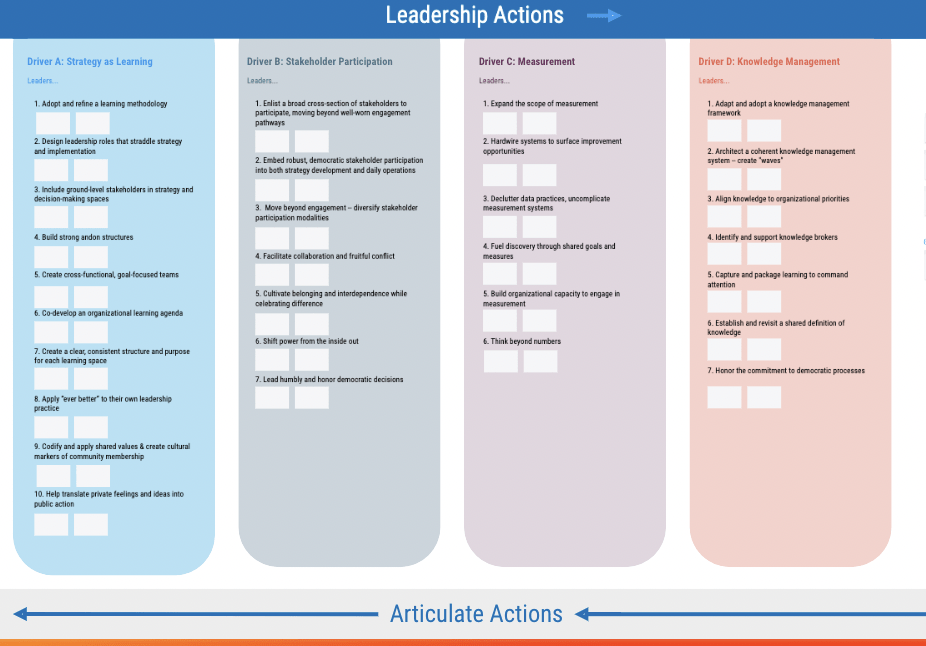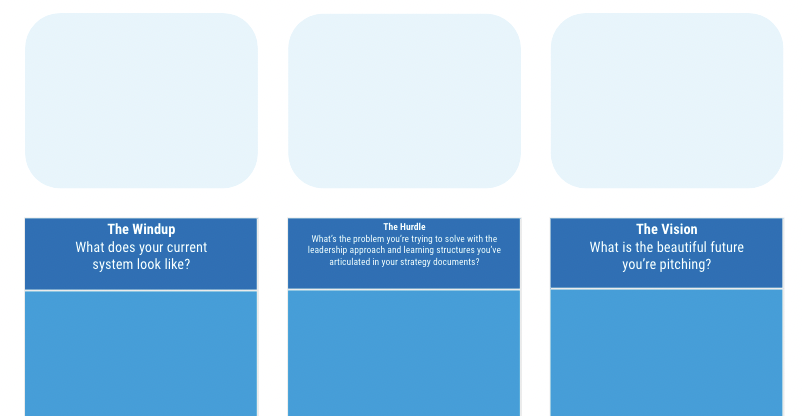Communicate your leadership approach with others
Timing - 60 minutes
In this activity, you will storyboard a pitch for your Theory of Leadership approach.
Back to Phase 3 overviewOverview
Finally, to move your approach work off the page and into practice, develop a memorable narrative to communicate your vision to various stakeholders within and beyond your immediate system.
The journey to becoming and persisting as a learning leader is challenging, and the leadership approach you’ve outlined may be countercultural to common models of leadership. In other words, you may be asking your community of stakeholders to behave in a very different way from what they are used to.
To rally sustained support—and to effectively spread and scale your approach if it proves to be effective—you will need to clearly communicate your vision with others. As we mentioned at the beginning of the Companion Guide, by completing this Theory, you are upending traditional approaches to education-based reform. But to ensure that reform is successful—and does not become just another of the many failed reforms that education workers have experienced—you need buy-in and support from the rest of your system.
The following activity will help you develop a compelling approach pitch that you can customize for different audiences.
Let’s get started.
Tools & Materials

Completed Theory of Leadership
Need support? Learn more about working with CPRL.
Protocol
Consider which audiences you’ll need to communicate your Theory of Leadership with.
For example, if your Theory of Leadership represents a major departure from the way you have previously organized and led learning, you may need to share it with those you lead, system or organizational leaders, and other colleagues.
If the Theory of Leadership you have captured is similar to the tacit approach you have been using, it may be helpful to consider how you will share it with outsiders (e.g., peers in other organizations) or newcomers to your organization (e.g., new hires, a new cohort in a network).
Mark down those audiences, and keep them in mind as you develop your pitch.
Navigate to the Tell Your Leadership Story activity template, and craft responses to each of the following prompts, inspired from Dan Roam’s Show and Tell: How Everybody Can Make Extraordinary Presentations.
Roam, D. (2016). Show & tell: How everybody can make extraordinary presentations. Portfolio/Penguin.
As you discuss each prompt, capture notes under each storyboard frame.
- The windup: What does your current system look like? When you started your Theory development process, you investigated your system, asking stakeholders to provide insight into how they currently navigate leadership and learning structures. Now is the time to share your findings. Be honest about the current landscape, emphasizing the assets and strengths that stakeholders bring to your system’s work.
- The vision: What is the beautiful future you’re pitching? Paint a compelling picture of the learning and improvement community you are looking to build, drawing from the vision you crafted in Phase 2. What will the learning community look and feel like? How will it differ from the systems that you have previously been part of? Your job is to communicate how such a system will move you toward the equity-driven outcomes you care about, including impacts for staff, students, families, and communities.
- The pitch: As a system leader, what is your role in helping realize that vision? Here’s where the meat of your pitch comes in. Offer your audience two competing strategies for reaching your vision: one that is untenable and another that is both compelling and possible (your Theory of Leadership).
One straightforward way to do this is to juxtapose a common leadership model that most staff will be familiar with—like bureaucracy—against the Leading Through Learning approach you’ve outlined. - The close: Why is your preferred approach the path forward? Make a case for why your approach is the more effective road toward your vision.
- The fine print and flourish: What support do you need to do to make this happen? Finally, be honest about the investment you will need to operationalize that approach and make your vision a reality. Outline how your audience can support and participate in the effort, and emphasize one final time why it is worth their time.
Review your notes and polish until there is a clear storyline.
Craft talking points for each part of your pitch.
If possible, limit your pitch to 5 minutes or less. Consider how you will need to adapt the pitch for different audiences.
Congratulations!
You have reached the end of the Leading Through Learning Companion Guide. You are ready to jump headfirst into learning leadership.
This will be hard work, but you are not alone. You can continue to use this Companion Guide and return to your Theory as your organization develops and grows. And at CPRL, we are always here to help. Contact us at cprl@law.columbia.edu with questions or feedback or to inquire about consulting support.

